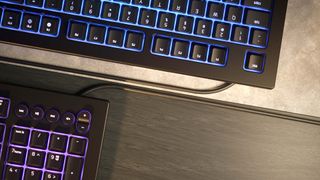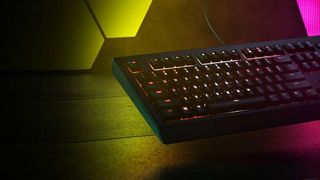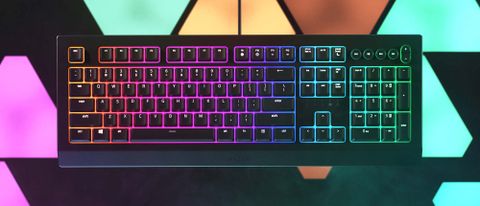Tom's Guide Verdict
The Razer Cynosa V2 offers decent RGB functionality and a few helpful bells and whistles, although it never quite transcends its membrane design.
Pros
- +
Robust RGB lighting
- +
Profiles and Game Mode
- +
Reasonable price
Cons
- -
Convoluted software
- -
Bulky, plain design
- -
So-so membrane keys
Why you can trust Tom's Guide
I'm of two minds about membrane gaming keyboards like the Razer Cynosa V2. On the one hand, PC gaming is supposed to cater to a wide range of tastes and budgets, and it's unreasonable to expect every PC gamer to dish out $150 - or more - for a full-featured mechanical keyboard. On the other hand, membrane gaming keyboards are often content to slap a few lights over a set of mushy office keys and call it a day.
Key Type: Membrane
Switch Type: N/A
Illumination: Full RGB
Size: 18.2 x 6.1 x 1.2 inches
Prospective purchasers can take heart, though: the Razer Cynosa V2 is one of the good ones. Razer put in a good-faith effort to imbue a membrane keyboard with some relevant and useful features, such as individual profiles, a game mode, and full per-key RGB lighting. The whole package costs only $60, which is considerably less than even a tenkeyless mechanical model from a known brand.
- The best keyboards for every user
- A guide to mechanical keyboard switches
- Logitech G Pro X Keyboard review
On the other hand, the Cynosa V2's keys don't feel great, for either productivity or gaming. Typing is a little bit slower and less accurate, while game performance feels less satisfying and immediate. The Cynosa V2 is also held back by its large, bulky profile and a difficult procedure to activate per-key lighting.
The Razer Cynosa V2 isn't quite one of the best gaming keyboards, but it's a solid investment for those just starting out in the PC gaming space. Read on to discover the device's strengths and weaknesses in our Razer Cynosa V2 review.
Razer Cynosa V2 review: Design
Without the RGB lighting activated, the Razer Cynosa V2 could be mistaken for an office keyboard. This is both a good and a bad thing. While I like the fact that the Cynosa V2 doesn't scream "gaming keyboard," it doesn't exactly scream anything else, either. It's a black keyboard with a small Razer logo at the bottom. There are no other adornments.

On the other hand, the Cynosa V2 has pretty much every physical feature I like to see in a keyboard. There's a cable routing system in the back, and a set of media keys in the upper-right corner. (This is a huge improvement over the first Razer Cynosa.) The elongated bottom isn't exactly a wrist rest, but it's better than offering no wrist support at all.
Either way, the Cynosa V2 is plain - and moreover, it's large. At 6.1 inches, its width isn't too bad, but at 18.2 inches, you'll need a mighty desk to support this. Other companies have demonstrated that you can squeeze a functional full-size keyboard into 17.5 inches or less, and it seems like the Cynosa V2 could have saved some space, especially at the right and left edges.
Razer Cynosa V2 review: Keys
The primary reason why the Razer Cynosa V2 doesn't cost much, as gaming keyboards go, is because it employs membrane keys rather than mechanical key switches. While I generally recommend mechanical keyboards, their high prices make them prohibitive for neophyte PC gamers. As membrane keyboards go, the Cynosa V2 is thoroughly OK, although its feel is not radically different from a Dell, HP or Microsoft office model.

From a qualitative perspective, the Cynosa V2's keys are unremarkable. You depress them; they give tactile feedback; they spring back up. The keys travel a comfortable distance, and the letters are spaced out well. There's nothing really satisfying about using them, though; they're quiet and don't feel like much.
They're also not fantastic for typing. Using a Typing.com test, I scored 119 words per minute with 98% accuracy on the Cynosa V2, compared to 135 words per minute with 99% accuracy on my usual Logitech G810. If I had to guess, the keys simply don't register or spring back as quickly as their mechanical counterparts.
Razer Cynosa V2 review: Features
One thing the Razer Cynosa V2 offers, which is otherwise quite rare among gaming keyboards, is per-key RGB lighting. The lights are not quite as vivid as on other Razer keyboards, but if you want to make every single key a slightly different color than the one next to it, you can do so. It's just an enormous pain in the rear.

If you want to assign a preprogrammed lighting pattern on the Cynosa V2, all you have to do is open up the Razer Synapse software and pick one from a list. You get Spectrum Cycling, Ripple, Rainbow Wave and all the other usual suspects. But if you want to program each key individually, you'll need to download the complicated and unintuitive Chroma Studio. Without giving a full tutorial on how it works, it's a deep and complex program that requires a lot of trial and error, particularly if you want to add effects on top of static lighting. While Razer's claim of per-key RGB lighting is completely true, I wonder how many people will have the tenacity to go through with it.
Otherwise, the Synapse software works well enough for reprogramming keys, linking profiles with programs and enabling or disabling Game Mode. This lets you disable certain key combinations (such as Alt + F4 or Alt + Tab) during gameplay so that you don't accidentally shut your game off during a heated multiplayer session. It's a standard feature among gaming keyboards, but it's a strong argument to spend $60 on the Cynosa V2 rather than, say, $20 on a decent Microsoft office peripheral.
Razer Cynosa V2 review: Performance
In terms of gameplay, I had no complaints about the Razer Cynosa V2. While the keys aren't quite as snappy or springy as a mechanical model's, that's not much of a concern when playing single-player games, or multiplayer games at a casual level. While split-second response time probably matters at the highest levels of play, I didn't notice any difference in input between the Cynosa V2 and the Logitech G810.

I tested the Cynosa V2 with Doom Eternal, Age of Empires II: Definitive Edition, Shadow of the Tomb Raider and World of Warcraft. The performance was good across the board, whether I was leaping between demons and blasting them to smithereens, or running from hordes of warriors in ancient catacombs. The Cynosa V2 is perfectly good for everyday play, although as stated above, I'd be hesitant to dive into tournament-grade multiplayer matches.
Razer Cynosa V2: Verdict
When the first Razer Cynosa came out a few years ago, I liked it, but didn't love it. I feel the same way about its successor, as our Razer Cynosa V2 review discussed. While the keys are so-so and the design is plain, the device offers all the features you'd expect from a gaming keyboard at a reasonable price.
In the same general price range, I think the SteelSeries Apex 3 is also worth considering, as it costs $10 less. On the other hand, the Cynosa V2's Game Mode alone might be worth the difference in price. If you can save up for a mechanical gaming keyboard, that would still be my first recommendation. But if membrane is your key type of choice, the Razer Cynosa V2 could very well be the gaming keyboard you've been waiting for.
Marshall Honorof is a senior editor for Tom's Guide, overseeing the site's coverage of gaming hardware and software. He comes from a science writing background, having studied paleomammalogy, biological anthropology, and the history of science and technology. After hours, you can find him practicing taekwondo or doing deep dives on classic sci-fi.


